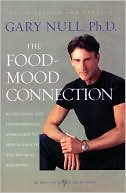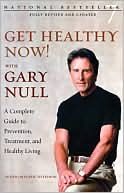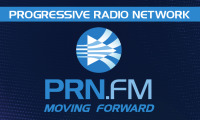THE HEART OF THE MATTER: Understanding and Reversing Cardiovascular Disease
 April 25, 2011
April 25, 2011 
By Gary Null
More people suffer from cardiovascular disease than from any other condition. Cardiovascular disease, including stroke, is an ongoing process. You don't wake up one day and suddenly have a heart attack. Similarly, the underlying reason you have a stroke is not something that happened ten minutes ago. No, both of these events represent a terrible breakdown in your system. An accumulation of toxic and inflammatory reactions has reached the state at which your body can no longer defend itself That is when you end up going into crisis. When that happens, you'll want to investigate every major way to fortify and protect your body, and use the most appropriate ones.
But here's the question I'm always asking: Why not take up the task of educating yourself and correcting your habits before a crisis occurs? After all, by the time you have a heart attack or stroke, you've probably been doing the wrong things for twenty, thirty, or forty years. If you suspect that last sentence applies to you, I recommend a change of course right now. It makes so much more sense than waiting for an unpleasant health event.
A FRESH APPROACH TO HEART DISEASE
The first thing you should know is that a lot of what we call heart disease has been misdiagnosed. Why? During the 1950s and '60s, the "big thing" was cholesterol. At that time, medical authorities were looking into blocked arteries. They saw that an artery could be 80 to 90 percent blocked, causing high blood pressure, since it took greater pressure from the heart to push blood through this ever‑narrowing tube. The person with this blocked artery was a candidate for a heart attack, with kidney problems looming up ahead as well.
The researchers took tissue samples from these narrowed arteries and said that the primary ingredient was cholesterol, and they called for a cholesterol‑lowering diet. They made cholesterol the primary risk factor for heart disease (along with cigarette smoking). This was a premature and only partially correct answer.
We now know that cholesterol is not a risk factor per se, and that this substance is, in fact, vital to the health of every cell in your body. However, the LDLs, or low‑density lipoproteins, are the real danger. They contain high levels of cholesterol, and when they are elevated, they become a major risk factor for building up plaque in the arteries.
Today we know that a safe level of cholesterol is around 150, and an unsafe level is 200. If you have normal blood chemistry with no inflammatory processes going on‑no fibrinogen, homocysteine, or C‑reactive protein‑you have a chance of living a relatively normal life. If you have a cholesterol level of 200, together with inflammatory processes, you then have a great chance of dying prematurely. So the true risk is the entire chemical picture of your body, not just cholesterol by itself.
In the 1990s, we discovered that cholesterol was building up where there were tiny little lesions, little scabs, on the arterial wall. Why were the lesions there? Doctors learned that they were caused by oxidative stressors, such as free radicals and other factors that cause inflammation. But cholesterol was still seen as the culprit. The situation was analogous to the following: You cut yourself, and as part of the recovery process a scab soon develops. However, someone then diagnoses the scab‑rather than the sharp object that cut you‑as the cause of your problem. This is the fallacious reasoning that was put forth when cholesterol buildup in the lesions was blamed, instead of the free radicals that caused the lesions.
Today we find that oxidative stress, due to inflammations from nutritional and environmental hazards, is the primary cause of cancer, Alzheimer's disease, Parkinson's disease, arthritis, and all forms of heart disease. Here is an example: Heterocyclic amines are the byproducts of deep‑frying, barbecuing, or grilling something. Wellcooked meat is loaded with heterocyclic amines. These are extremely destructive. When you eat a hamburger, those heterocyclic amines are released into your system. Then they cause damage to the arterial wall. The body tries to repair this damage, but if the immune system is not strong enough, and if you have not been giving the body as many tools for immune repair as for immune destruction, the body will not have what it needs to fully repair the damaged arterial walls. The lesions thus remain partially unhealed, and plaque starts to build up in them.
That is when Dr. Dean Ornish and others observed that freeradical scavengers, including the antioxidants vitamin C, green tea, and garlic, stop the accumulation of plaque. By taking in phytonutrients (beneficial chemicals naturally found in plant foods and juices), especially in concentrated amounts, we speed up the healing process to the point at which we have actually reversed heart disease. We have reversed occlusion. We have lowered high blood pressure. And we have lowered elevated cholesterol.
And this brings up an important concept: What reverses a disease will also prevent a disease. So our dietary and lifestyle recommendations for people not yet suffering from heart disease are based on our protocols for reversing heart disease. And here is another concept that now seems correct: Just as one disease process can create multiple illnesses, a counter protocol can help avoid those many diseases. For example, giving up heterocyclic amines from highly cooked foods does more than just protect your heart. It protects your joints, your brain, your intestines, and your liver.
WHAT YOU CAN DO: THREE SPECIFIC PROTOCOLS FOR HEART HEALTH
First, a word of caution. When it comes to protocols, or specific programs, it is important to remember that they are designed to be done in an incremental fashion, under medical supervision. It is stated here in the strongest possible way that you must, you simply must follow this protocol under a holistic physician's supervision, ideally a boardcertified cardiologist.
A CARDIOVASCULAR PROTOCOL
Supplements
The following nutrients are needed for the cardiovascular system. It is not suggested that all of these be taken at once. That would be too much for the body, so take only a few at a time over the course of the day.
Coenzyme Qi 0 is a superstar in protecting the heart. It feeds the cell. It allows the transport of fatty acids to the cell so that the cell's mitochondria have the energy needed to function properly. This is especially important for the heart muscle, for obvious reasons!
I believe that if every American took between 100 to 300 mg of coenzyme Q10 a day, and if people with cardiovascular disease took between 300 to 500 mg of this wonder‑nutrient daily, we could be saving hundreds of thousands of lives a year. If you're taking a large amount of coenzyme Ql0, do so in divided doses. For example, if you are taking a total of 500 mg of coenzyme Q10, you should take 100 mg five times a day.
Calcium and magnesium from citrate (always taken together) in the amount of about 1,500 mg a day are a crucial pair of nutrients for the heart. There will be more information about magnesium, the most important but sadly neglected heart nutrient, below.
Other important substances include garlic (1,000 to 5,000 mg), onion (a raw onion a day helps keep strokes and heart attacks away), and L‑carnitine (500 to 1,000 mg). L‑carnitine increases energy by burning fat within the cell's mitochondria. This helps the body to recover quickly from fatigue. And L‑carnitine is especially good when combined with vitamin E, another superstar heart disease fighter, phosphatidylcholine (500 mg twice a day), DMG (dimethylglycine) (100 mg once a day), TMG (trimethyiglycine) (200 mg twice a day), Maxepa (fish oils) (1,500 mg), potassium (500 mg), selenium (200 mcg), melatonin (1‑3 mg), B complex (50 mg), vitamin C (2,000‑10,000 mg), DHEA (25 mg; do not use DHEA if you have cancer), chromium picolinate (200 mcg), chondroitin sulfate (500 mg two times a day), evening primrose oil (generally at 1,500 mg in divided doses), polycosinol (10 mg), and N‑acetyl cysteine (1,500 mg). Alpha‑lipoic acid (300 mg) is very important as a free‑radical scavenger.
Also very important for heart disease is natural (not synthetic) vitamin E (with tocotrienols and the gamma fraction) generally at 400 IU with tocotrienols at 100 mg. Biofiavonoids are also quite helpful. Make sure you have what are called methylating agents, namely vitamin B12, folic acid (800 units), and TMG. The essential fatty acids are just that‑essential! The two types are called omega‑3 and omega‑6. Fish oils are a source of omega‑3 and evening primrose oil is a source of omega‑6. Generally, 3,000 mg of omega‑3 and 2,000 mg of omega‑6 should be divided into three doses, daily.
L‑arginine facilitates the body's production of nitric oxide, which has an antiangina and antistress effect upon the arteries, enabling the muscles in the arterial walls to relax. This amino acid is generally taken at 2,000 to 3,000 mg per day.
Lecithin can reduce arterial plaque, lower blood pressure, and lessen angina pectoris. Take lecithin granules in one teaspoon in the morning (they can be sprinkled over cereal). Taurine, an amino acid that acts as an antioxidant, can help fortify cardiac contractions and consequently enhance the outflow of blood from the heart. Take it generally at 500 mg. Niacin (vitamin 133) has been shown to help prevent heart attacks. It also helps prevent people from dying from them.
Mineral for the Heart
Magnesium is the single most important mineral for the heart. Generally, people don't realize that a magnesium‑deficient heart is almost always more susceptible to heart attack. This brings up the everimportant concept of the preventive approaches. Logic suggests that if filling a specific nutrient deficiency in a sick person ameliorates the condition, then giving a healthy person that nutrient in more than adequate amounts should prevent the condition from developing in the first place. In the case of heart disease, we see certain nutrients, such as magnesium, that are deficient in all patients. Common sense would then dictate that giving more than adequate amounts of these nutrients to people will help prevent or reverse heart disease.
Herbs for Heart Health
There are some herbs that are excellent for promoting cardiovascular health. Cayenne is a superstar because it contains the active ingredient capsaicin. Capsaicin lowers blood pressure and cholesterol and prevents heart attacks and strokes. It is a natural blood thinner. However, it is not safe for everyone to take this herb, because for those taking certain medications, such as Coumadin (warfarin), there could be contraindications. So you have to ask your physician if any prescription drug you are taking may prohibit the use of cayenne. This is very important.
Otherwise, cayenne, best known as the spice cayenne pepper, should definitely be used, but carefully, because it is very hot! If you use this as a spice, do not cook the pepper with the food but sprinkle it on food only after cooking the food, to avoid irritation.
Hawthorn berry improves arrhythmias, angina, blood pressure, and arterial hardening. It can enhance circulation. It treats valve insufficiencies, irregular pulse, and abnormal acid levels in the blood. In short, it is a really terrific herb! Hawthorn is generally taken at 100 mg twice a day. Bugleweed helps alleviate heart palpitations and lowers blood pressure. Ginkgo biloba, the well‑known multipurpose herb, gets more blood flowing into the small blood vessels. It's suggested at 300 mg in divided doses. Motherwort helps secure cardiac electrical rhythm. Tansy is another herb used for heart palpitations, and it can be ingested as a tea. Wild yam enhances the body's production of DHEA, and DHEA is crucial in helping to prevent heart attacks. Arjuna is an Ayurvedic herb that enhances circulation and lowers blood pressure. Indian snakeroot also has anti‑hypertensive qualities. Black cohosh, an American herb, helps lower blood pressure.
We've said this before, but let's restate the warnings: It is not at all advisable to take all these substances at the same time. Instead, take one or two of these for a month, as professionally directed. Record the results. Then, under continued guidance, repeat or increase the dosage, or move on to different substances. Do not self‑medicate. These supplements are not meant as medicines. These are not meant to treat diseases, but only to augment the body's internal biochemistry, to help strengthen it, so that whatever else you are doing can be better applied.
Intravenous Treatments for Cardiovascular Health
There are several intravenous treatments that have proven very effective in the cardiovascular arena. EDTA chelation therapy is crucial, I believe, for treating coronary artery disease and arterial sclerosis. I have seen many people who were about to receive coronary bypass operations, or some other drastic treatment, improve tremendously, even dramatically, using chelation therapy. If you already have a heart condition, you have to be patient and courageous, because it may take some time, probably upwards of two years, to do this properly, but your life is worth it. We have seen from the literature that this therapy definitely works and that you can reclaim your life!
Vitamin C, taken intravenously, is another extremely important therapy given at a practitioner's office. This lifesaving treatment has been able to help people with cancer and heart disease, among many other conditions.
We have made the mistake of not looking at the body as a dynamic whole. We have looked at it as a series of separate broken‑down parts that each needs a specialist. So you have doctors working on one little part of the body‑the ear, the eye, the nose, the groin, the heart, the muscle, the lung, the spleen‑without understanding the dynamic of the whole. We never think that something as relatively simple as a dietary, exercise, or environmental factor could cause a myriad of body conditions, but it does. Once we accept this reality, we can adjust our approach to all types of heart disease.
 Email Article |
Email Article | 



